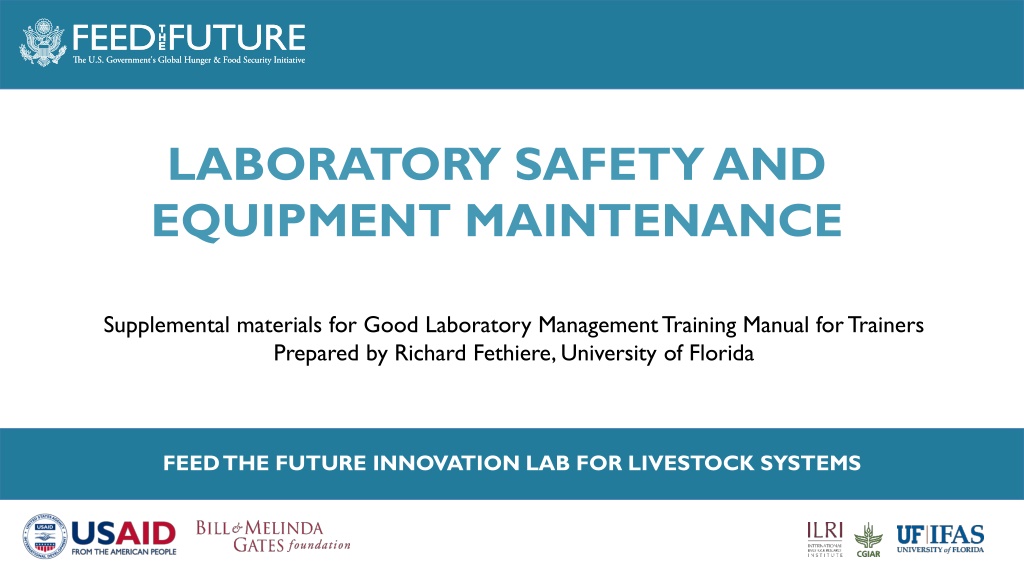Effective Laboratory Management: Safety, Equipment Maintenance, and Inventory Control
This comprehensive training manual covers essential topics such as laboratory safety, equipment maintenance, supplies and reagents inventory, chemical inventory management, and material safety data sheets. It emphasizes the importance of proper procedures to ensure a safe working environment and efficient laboratory operations. The manual also discusses equipment acquisition considerations, warranty inquiries, and the importance of maintaining a list of reliable suppliers.
Download Presentation

Please find below an Image/Link to download the presentation.
The content on the website is provided AS IS for your information and personal use only. It may not be sold, licensed, or shared on other websites without obtaining consent from the author. Download presentation by click this link. If you encounter any issues during the download, it is possible that the publisher has removed the file from their server.
E N D
Presentation Transcript
LABORATORY SAFETY AND EQUIPMENT MAINTENANCE Supplemental materials for Good Laboratory Management Training Manual for Trainers Prepared by Richard Fethiere, University of Florida FEED THE FUTURE INNOVATION LAB FOR LIVESTOCK SYSTEMS Photo Credit Goes Here
Supplies and reagents inventory Equipment acquisition Background Equipment maintenance Manual of the equipment Activity
SUPPLIES AND REAGENTS INVENTORY AN INVENTORY OF SUPPLIES AND REAGENTS MUST ALWAYS BE KEPT It should allow the lab to: Know what supplies are available to process the samples submitted Ensure that there are enough reagents and supplies to process the samples submitted The number of samples submitted will dictate the number of reagents and supplies to be stocked
CHEMICAL INVENTORY Important as it allows to know what and where dangerous chemicals are kept in the lab Allows to ensure that the Material Safety Data Sheets (MSDS) on each chemical is available MSDS =>Provides information on the chemical s characteristics and the potential dangers they create for users
MATERIAL SAFETY DATA SHEETS Provides info on how to treat potential exposure to dangerous chemicals should they occur Helps to know what supplies to stock in the lab to answer to an emergency caused by dangerous chemicals Helps determine the Personal Protective Equipment (PPE) that the staff must use
MATERIAL SAFETY DATA SHEETS (2) Helps determine the Personal Protective Equipment (PPE) that the staff must use, for instance, lab coats, gloves, and goggles Helps determine if the use of a fume hood is necessary to protect the researchers using the laboratory facilities
EQUIPMENT ACQUISITION Does the company provide maintenance? Do you have the contact info of the company? What What does the equipment come with? Any special options required? (UV) Is there a warranty? For how long? equipment to buy? Why? It is necessary to keep a list of current suppliers as businesses come and go, or circumstances like days with the coronavirus creates new suppliers of new products: https://www.thomasnet.com/articles/top-suppliers/medical-testing-kits-suppliers/
EQUIPMENT MAINTENANCE Essential for lab to work efficiently! Efficient work = Equipment that works You should be familiar with the equipment
MANUAL OF THE EQUIPMENT Should be read thoroughly before installation and use of equipment Should always be on hand at the lab
EQUIPMENT USE TRAINING Try to have more than one (1) person to attend If an employee leaves, there should be more people familiar with the equipment Ideally: Lab director Lab manager Lab technician At least one student
WHAT TO LOOK FOR IN A MANUAL? Description of equipment: Model and serial number Name of every part and their use Expected maintenance cycles: What type of maintenance does the equipment require? How often?
PREVENTIVE MAINTENANCE AND TROUBLESHOOTING Preventive maintenance: How often to change a certain component? Are there filters that require constant monitoring? Are there tubes that need to be replaced? Are there bulbs that require to be changed? Troubleshooting Read thoroughly to be prepared for potential common failures and solutions to these failures
TROUBLESHOOTING SECTION Read thoroughly to be prepared for potential common failures and solutions to these failures
EQUIPMENT AND TOOLS All parts of the equipment: If you need a replacement part, you need to know the exact model to order it Tools required: Do you need any special tools to execute common maintenance tasks?
ACTIVITY: LABORATORY TOOLBOX
EVERY LAB REQUIRES A SMALL TOOLBOX You need to have basic items like Screwdrivers Electrical tape Wrenches Small saw Flashlight Other recommended in the manuals
Consult the Good Laboratory Management Training Manual for Trainers https://livestocklab.ifas.ufl.edu/resources/glp/ Direct link to manual in PDF: https://livestocklab.ifas.ufl.edu/media/livestocklabifasufledu/pdf-/MANUAL- Fethiere_UF_Good-lab-management-practices_2022.pdf
Feed the Future Innovation Lab for Livestock Systems https://livestocklab.ifas.ufl.edu/ (Subscribe to newsletter) livestock-lab@ufl.edu Disclaimer This work was funded by the United States Agency for International Development (USAID) Bureau for Food Security under Agreement #AID-OAA-L-15-00003 as part of Feed the Future Innovation Lab for Livestock Systems, and by the Bill & Melinda Gates Foundation OPP#1175487. Any opinions, findings, conclusions, or recommendations expressed here are those of the authors alone.






































